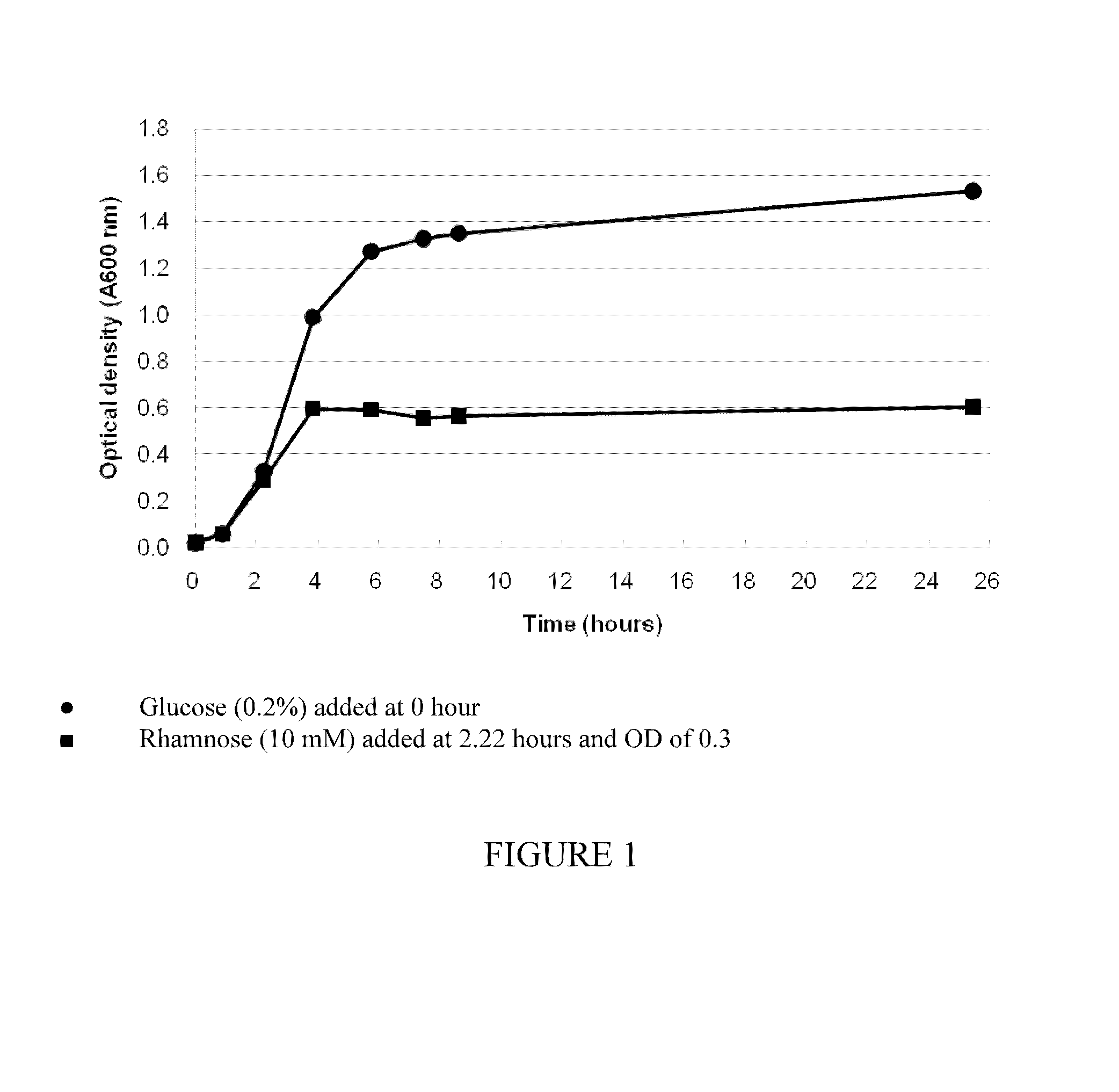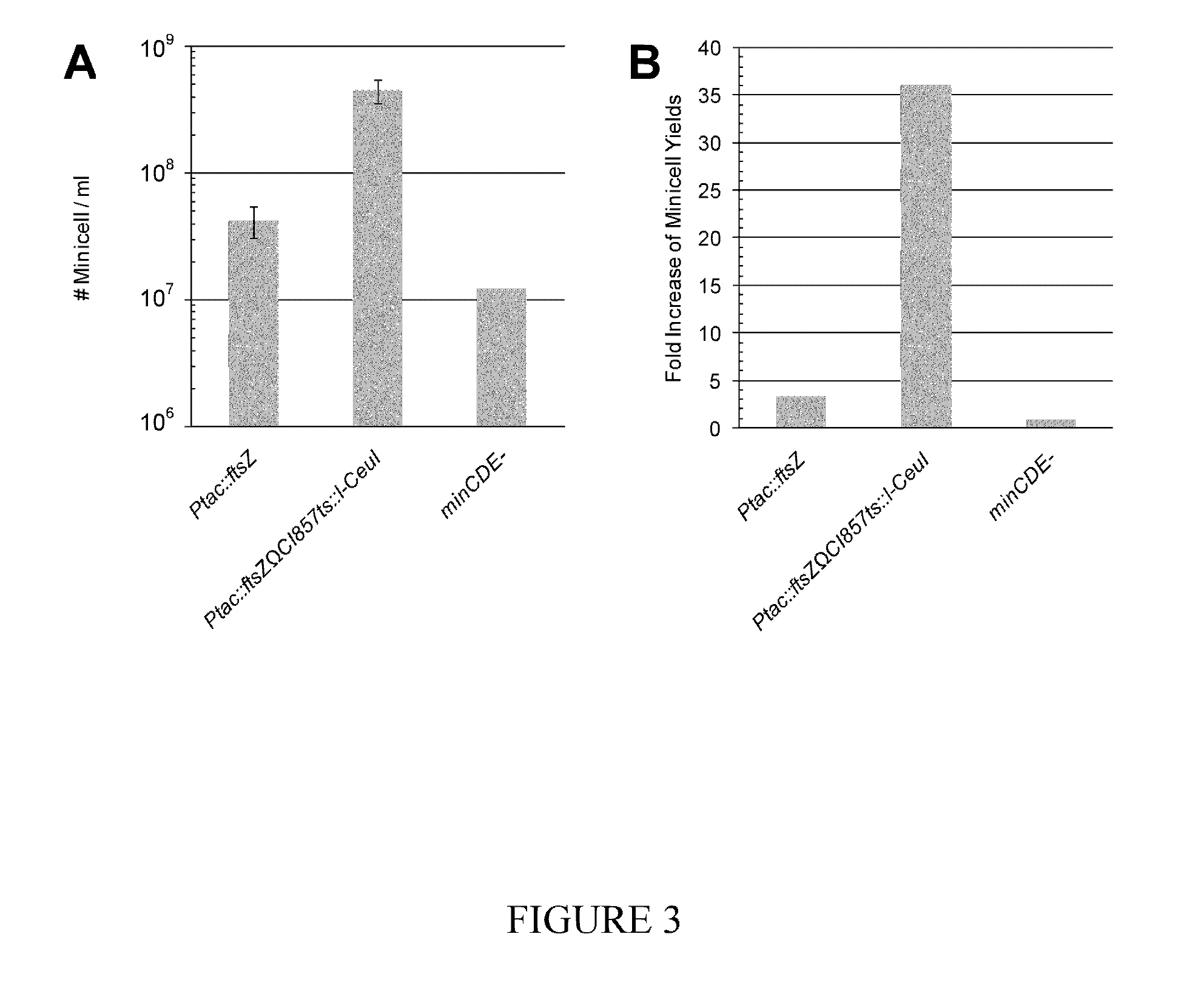Regulated genetic suicide mechanism compositions and methods
a genetic suicide mechanism and composition technology, applied in the field of regulated genetic suicide mechanism compositions and methods, can solve the problems of non-dividing and non-viability, and achieve the effect of reducing the pro-inflammatory immune respons
- Summary
- Abstract
- Description
- Claims
- Application Information
AI Technical Summary
Benefits of technology
Problems solved by technology
Method used
Image
Examples
example 1
Effects of I-CeuI on the Growth of E. coli
[0151]E. coli TOP10 cells were transformed with pVX-55 expression vector (SEQ ID NO:6). The pVX-55 expression vector contains an I-CeuI gene under the control of the rhamnose inducible pRHA promoter system. The transformed E. coli cell culture was grown in LB broth supplemented with Kanamycin (50 μg / ml). Glucose (0.2%) was added into the cell culture at 0 hours, and rhamnose (10 mM) were added into the cell culture at 2.22 hours and OD of 0.3. Growth of the bacterium was monitored by measuring absorbance at 600 nm. FIG. 1 shows that the growth of the E. coli cell culture was significantly reduced by the induction of I-CeuI homing endonuclease.
example 2
Effects of I-CeuI on Viability of E. coli
[0152]E. coli TOP10 cells were transformed with pVX-55 expression vector. The pVX-55 expression vector contains an I-CeuI gene under the control of the rhamnose inducible pRHA promoter system. The E. coli cells was cultured in LB broth with Kanamycin (50 μg / ml) supplemented with glucose (0.2%) or rhamnose (10 mM) before spotted on LB agar plates. Viable cell populations (CFU / ml) were determined via colony counts on LB agar plates. No recovery of colonies was observed. FIG. 2 shows that the number of viable E. coli cells was significantly reduced by the induction of I-CeuI homing endonuclease.
example 3
Simultaneous Overexpression of ftsZ and Induction of I-CeuI (MSM) Lead to Higher Minicell Yields
[0153]An E. coli strain containing IPTG inducible ftsZ and minCDE deletion mutation were grown in LB medium. A ftsZ construct (Ptac::ftsZ) and a ftsZ construct with the heat inducible I-CeuI based suicide system (Ptac::ftsZΩCI857ts::I-CeuI) were integrated into the attBλ site on the chromosome of the minicell-producing E. coli cells, respectively. Minicell productions of the Ptac::ftsZ strain was conducted at 37° C. and minicell products of the Ptac::ftsZΩCI857ts::I-CeuI strain was conducted at 42° C. to induce the I-CeuI based suicide system. Minicells were purified via differential purifications. FIG. 3A shows the numbers of minicells purified from each ml of LB cultures used for minicell productions. FIG. 3B shows the ratios of minicell yields of the IPTG inducible ftsZ strains against the minCDE-strain. FIGS. 3A and 3B demonstrates that when ftsZ and I-CeuI were simultaneously overexp...
PUM
| Property | Measurement | Unit |
|---|---|---|
| temperatures | aaaaa | aaaaa |
| temperature | aaaaa | aaaaa |
| temperature | aaaaa | aaaaa |
Abstract
Description
Claims
Application Information
 Login to View More
Login to View More - R&D
- Intellectual Property
- Life Sciences
- Materials
- Tech Scout
- Unparalleled Data Quality
- Higher Quality Content
- 60% Fewer Hallucinations
Browse by: Latest US Patents, China's latest patents, Technical Efficacy Thesaurus, Application Domain, Technology Topic, Popular Technical Reports.
© 2025 PatSnap. All rights reserved.Legal|Privacy policy|Modern Slavery Act Transparency Statement|Sitemap|About US| Contact US: help@patsnap.com



